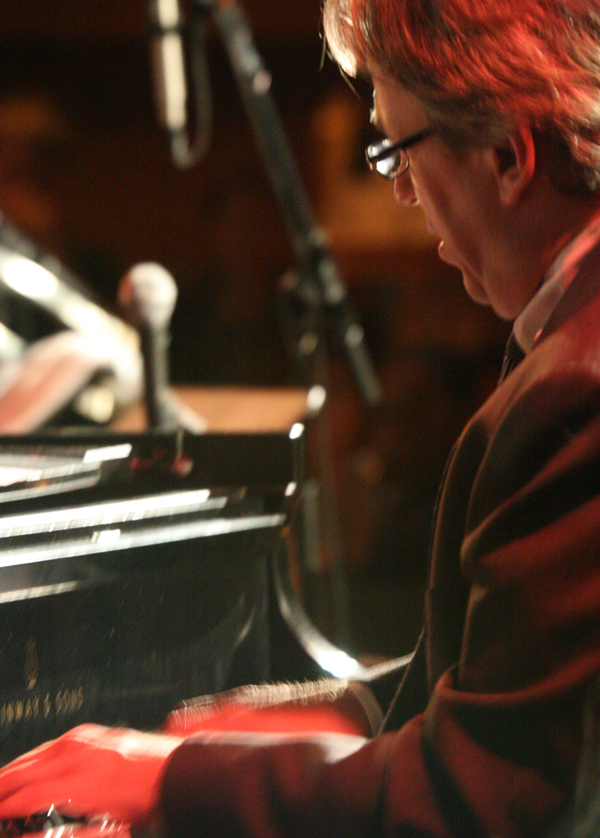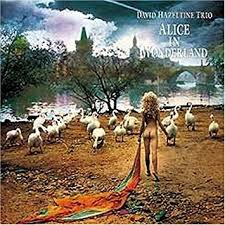For Bill – David Hazeltine
This medium-up song is influenced by a different side of Bill Evans than Hazeltine's earlier tribute Bill At Peace. A solo piano arrangement, performed by Kenny Drew, Jr., is available.
- Recording: David Hazeltine - Alice In Wonderland
- Recorded on: July 21-22, 2003
- Label: Venus (TKCJ-35183)
- Concert Key: C
- Vocal Range: , to
- Style: Swing (medium up)
- Piano - David Hazeltine
- Bass - George Mraz
- Drums - Billy Drummond
0:00
0:00
Buy MP3
Video
- Description
- Historical Notes
- Solos
- Piano Corner
- Bass Corner
- Drum Corner
- Guitar Corner
- Inside & Beyond
- Minus You
Hazeltine followed up Bill At Peace, a Bill Evans tribute in 3/4, with this one in 4/4. For Bill has a light touch at a medium-up tempo. The rhythmic feel on the head is generally a loose 2-feel, sometimes more like a 1-feel; important bass rhythms are shown in the lead sheet. Though this song is in a major key, the beginning of the melody has a plaintive sound suggesting the relative minor. The changes cover a lot of ground in terms of tonalities. A modulation to A minor in the fifth measure is followed by minor 7th chords moving stepwise and then resolving to A♭maj7 in the ninth measure (the B section). Another series of stepwise minor chords and II-V7s leads to a delayed resolution in F major on the ninth measure of this section: C7 goes to E7(♯9) and then Fmaj7. There are rhythm section hits in these four measures, which lead back to the tonic creating a 12-measure section. In the last two measures of this B section the melody, which is mostly lyrical, becomes more rhythmic in a descending phrase over a cadence with some tritone substitution.
The C section begins the same as A, but goes to A7sus instead of Am7, developing the opening melodic phrase more than in the A section. Dm7 in the seventh measure of this section begins a long harmonic descent for much of the rest of the form. The D section has a more rhythmic melody which rises mostly in contrary motion to the general harmonic direction, followed by the same descending phrase from the end of the B section. This is harmonized differently and resolves to B7(♯9) at the end of this 10-measure section. It's all there—this composition really captures the sort of post-bop impressionism that is the Bill Evans sound.
The solo changes are mostly simplified, except in the D section. Like some other Hazeltine songs, this one never resolves to the tonic at the end of the chorus; the coda tags the phrase from the last four measures, starting a step higher (not an exact transposition) and resolving in E major.
Our lead sheet shows some countermelodies that David plays to fill in some rests in the head, for example a chromatic line in the fourth measure. David interprets the melody expressively, not playing all the exact rhythms indicated in our lead sheet. Click on the Piano Corner tab for information about the Solo Piano Arrangement.
The C section begins the same as A, but goes to A7sus instead of Am7, developing the opening melodic phrase more than in the A section. Dm7 in the seventh measure of this section begins a long harmonic descent for much of the rest of the form. The D section has a more rhythmic melody which rises mostly in contrary motion to the general harmonic direction, followed by the same descending phrase from the end of the B section. This is harmonized differently and resolves to B7(♯9) at the end of this 10-measure section. It's all there—this composition really captures the sort of post-bop impressionism that is the Bill Evans sound.
The solo changes are mostly simplified, except in the D section. Like some other Hazeltine songs, this one never resolves to the tonic at the end of the chorus; the coda tags the phrase from the last four measures, starting a step higher (not an exact transposition) and resolving in E major.
Our lead sheet shows some countermelodies that David plays to fill in some rests in the head, for example a chromatic line in the fourth measure. David interprets the melody expressively, not playing all the exact rhythms indicated in our lead sheet. Click on the Piano Corner tab for information about the Solo Piano Arrangement.
As Bill At Peace is on "Waltz For Debby," For Bill is the only Hazeltine original on a trio album with George Mraz and Billy Drummond. Like "Waltz For Debby," ""Alice In Wonderland" is a Bill Evans tribute album, but instead of Evans originals, the other songs are standards that Evans recorded. Hazeltine first recorded with Billy Drummond on Joe Locke's 1998 album "Mutual Admiration Society" (check out Tears In Her Heart from this album).
Solo Piano Arrangement Pianist Kenny Drew, Jr. spent a few days at the Van Gelder Recording Studio in March of 2009, treating Rudy and the jazzleadsheets.com team to readings of Second Floor Music's Solo Piano Arrangements. Hear him interpret For Bill .
The arrangement Kenny played, by David, is available. Much of the melody is voiced in both hands, except for some pickups and measures 9-10 of the B section. In these two measures the melody is a single line accompanied by two-handed chordal hits which fill in around the melody notes. The countermelodies that are shown in the lead sheet are also part of David's arrangement. The coda (the last three measures) has a different rhythm from the recording, with the first measure all in quarter-note triplets. These measures are the extended ending, they would not be used in soloing.
The arrangement Kenny played, by David, is available. Much of the melody is voiced in both hands, except for some pickups and measures 9-10 of the B section. In these two measures the melody is a single line accompanied by two-handed chordal hits which fill in around the melody notes. The countermelodies that are shown in the lead sheet are also part of David's arrangement. The coda (the last three measures) has a different rhythm from the recording, with the first measure all in quarter-note triplets. These measures are the extended ending, they would not be used in soloing.
Related Songs
Email Send For Bill to a friend
Send this page to a friend via email. Add your name or email in the first field. In the second, add one or more email addresses, separated by a comma.

David Hazeltine
born on October 27, 1958
Heralded by pianist Cedar Walton as the "brightest star on jazz piano's horizon," David Hazeltine is considered to be one of jazz's premier pianists as well as composer-arrangers. With a mantra to "swing as much as humanly possible," David's style is infused with influences of Art Tatum, Bud Powell, Buddy Montgomery, Barry Harris and Cedar Walton while still retaining his own fiercely individual voice. Hailing from Milwaukee, David made his professional debut on the organ when he was just thirteen years old. Read more...
There was a problem.
...

